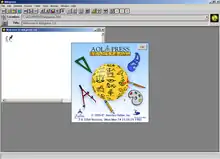AOLpress
AOLpress is a discontinued HTML editor that was available from America Online (AOL). It was originally developed as NaviPress by the company NaviSoft before being bought by AOL. It was discontinued in 2000. However, the last version (2.0) may still be found on some Web sites for downloading.
 AOLpress on Windows 2000 | |
| Original author(s) | NaviSoft |
|---|---|
| Developer(s) | AOL |
| Initial release | February 1994 |
| Final release | 2.0
|
| Operating system | Windows 95, Windows NT |
| Type | HTML editor |
AOLpress was rather strict about enforcing legal HTML: when saving edited pages that were created outside AOLpress, code that did not conform to the HTML 3.2 standard and specifications may have been changed to do so. Today, the HTML code used is very outdated and may not work correctly in modern browsers. It does not support PNG images, and this limits its support on many sites where the newer PNG format has been adopted.
History
In February 1994, NaviSoft Inc. released NaviPress, which was a Web browser with an integrated HTML editor. NaviPress was very similar to the first Web browser, WorldWideWeb, created by Tim Berners-Lee,[1] for the classic Mac OS and Microsoft Windows.[2] According to Berners-Lee, "NaviPress was a true browser and editor, which produced clean HTML."[3]
In late 1995, AOL acquired NaviSoft,[4] and the package was renamed "GNNPress", then later "AOLpress", and made available for downloading on AOL's Global Network Navigator site.[5] AOL then allowed each username to publish up to 2 megs on the web.[6]
In Weaving the Web, Berners-Lee attributes the death of AOLpress to the release of Netscape Navigator 2.0 in 1996. AOL's Steve Case reached an agreement with Bill Gates so that AOL users could use a version of the Explorer browser, which did not have HTML editing functionality. This agreement led to the decline of AOLpress. According to Berners-Lee, AOLpress was, at the time, "one of the few commercial browsers that provided simple online editing."[7]
In 1998, AOLpress made PC Magazine's "Best Products of the Year" issue. The editors describe it as "the only program that combines WYSIWYG Web page editing, HTML source code editing, Web site management, and Web browsing in a single interface." The article goes on to say that AOLpress "isn't simply an editor that looks like a browser. It is a browser."[8]
System requirements
AOLpress 2.0 requires 8 megabytes of RAM, with more recommended, a display capable of at least 256 colors, an Intel 80386 CPU, 8 megabytes of free disk space, and either Windows NT or Windows 95 operating system.
While the installer is 16-bit and will not work under 64-bit Windows to install the software, AOLpress is capable of launching even under Windows 8, though it generally crashes within a short time after starting. Although the program is not accepted by Windows 7, it will run in compatibility mode in Windows 10.
References
- Berners-Lee, Tim (August 1996). "The World Wide Web: Past, Present and Future". World Wide Web Consortium. Retrieved 25 August 2010.
- Stewart, Bill. "Web Browser History". Archived from the original on 20 January 2011. Retrieved 18 August 2010.
- Berners-Lee, Tim (2000). Weaving the Web. New York, NY: Harper Collins. p. 81. ISBN 0-06-251587-X.
- Jang, Michael; Arman, Danesh (2006). Mastering Linux. John Wiley & Sons. p. 714. ISBN 9780782152777. Retrieved March 18, 2015.
- "GNN Downloads". gnn.1campusa.com. 2007. Archived from the original on September 19, 2013. Retrieved June 5, 2013.
- "A Web Site is Not So Terribly Hard to Weave". Los Angeles Times. 31 March 1997.
- Berners-Lee, Tim (2000). Weaving the Web. New York, NY: Harper Collins. p. 112. ISBN 0-06-251587-X.
- "AOLpress: The Price Is Right". PC Magazine: 81. January 6, 1998. Retrieved March 18, 2015.
External links
- AOLpress website (redirects to the AOL website)
- AOLpress at the Wayback Machine (archived June 19, 2000)
- AOLPress on the Evolt Browsers Archive